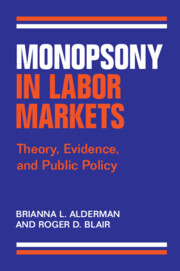Book contents
- Monopsony in Labor Markets
- Monopsony in Labor Markets
- Copyright page
- Dedication
- Contents
- Figures
- Tables
- Preface
- Acknowledgments
- 1 Monopsony in the Labor Market
- 2 The Economics of Monopsony
- 3 Empirical Evidence of Monopsony in Labor Markets
- 4 Antitrust Policy in the United States
- 5 The Intended and Unintended Victims of Monopsony
- 6 Collusion on Wages and Terms of Employment
- 7 No-Poaching Agreements
- 8 Noncompete Agreements
- 9 Unions and Collective Bargaining
- 10 Monopsony and Merger Policy
- 11 Closing Thoughts
- Index
4 - Antitrust Policy in the United States
Published online by Cambridge University Press: 08 February 2024
- Monopsony in Labor Markets
- Monopsony in Labor Markets
- Copyright page
- Dedication
- Contents
- Figures
- Tables
- Preface
- Acknowledgments
- 1 Monopsony in the Labor Market
- 2 The Economics of Monopsony
- 3 Empirical Evidence of Monopsony in Labor Markets
- 4 Antitrust Policy in the United States
- 5 The Intended and Unintended Victims of Monopsony
- 6 Collusion on Wages and Terms of Employment
- 7 No-Poaching Agreements
- 8 Noncompete Agreements
- 9 Unions and Collective Bargaining
- 10 Monopsony and Merger Policy
- 11 Closing Thoughts
- Index
Summary
The exercise of monopsony in labor markets is limited to one degree or another by public policy. Employer conduct aimed at creating monopsony power is governed by the Sherman Act of 1890, which forbids collusion among employers as well as competitively unreasonable conduct by a single employer.
This chapter discusses private suits and the prohibition of §1 and the sanctions for violations. Corporations are subject to fines while individuals may be fined and/or imprisoned. Section 1 forbids collusive restraints of trade. In the past, there was some confusion regarding the applicability of §1 to labor markets. These days are gone. The Department of Justice and Federal Trade Commission have issued their Antitrust Guidance for Human Resource Professionals in which the agencies make it crystal clear that they will pursue criminal convictions for collusion in labor markets. In addition to public sanctions, §4 of the Clayton Act provides a private right of action for antitrust victims.
- Type
- Chapter
- Information
- Monopsony in Labor MarketsTheory, Evidence, and Public Policy, pp. 50 - 61Publisher: Cambridge University PressPrint publication year: 2024



